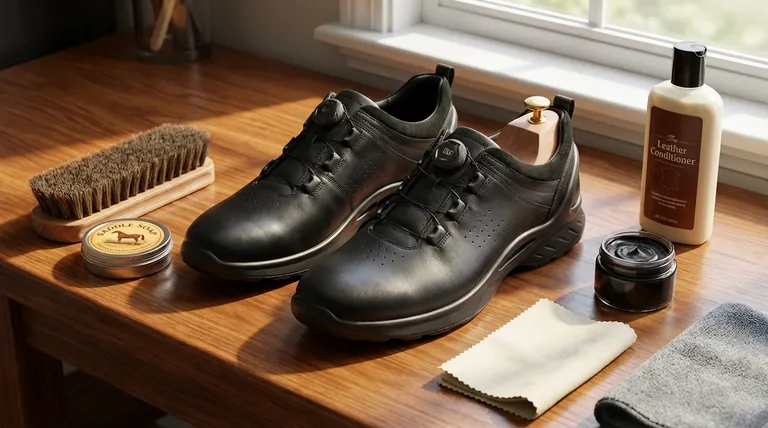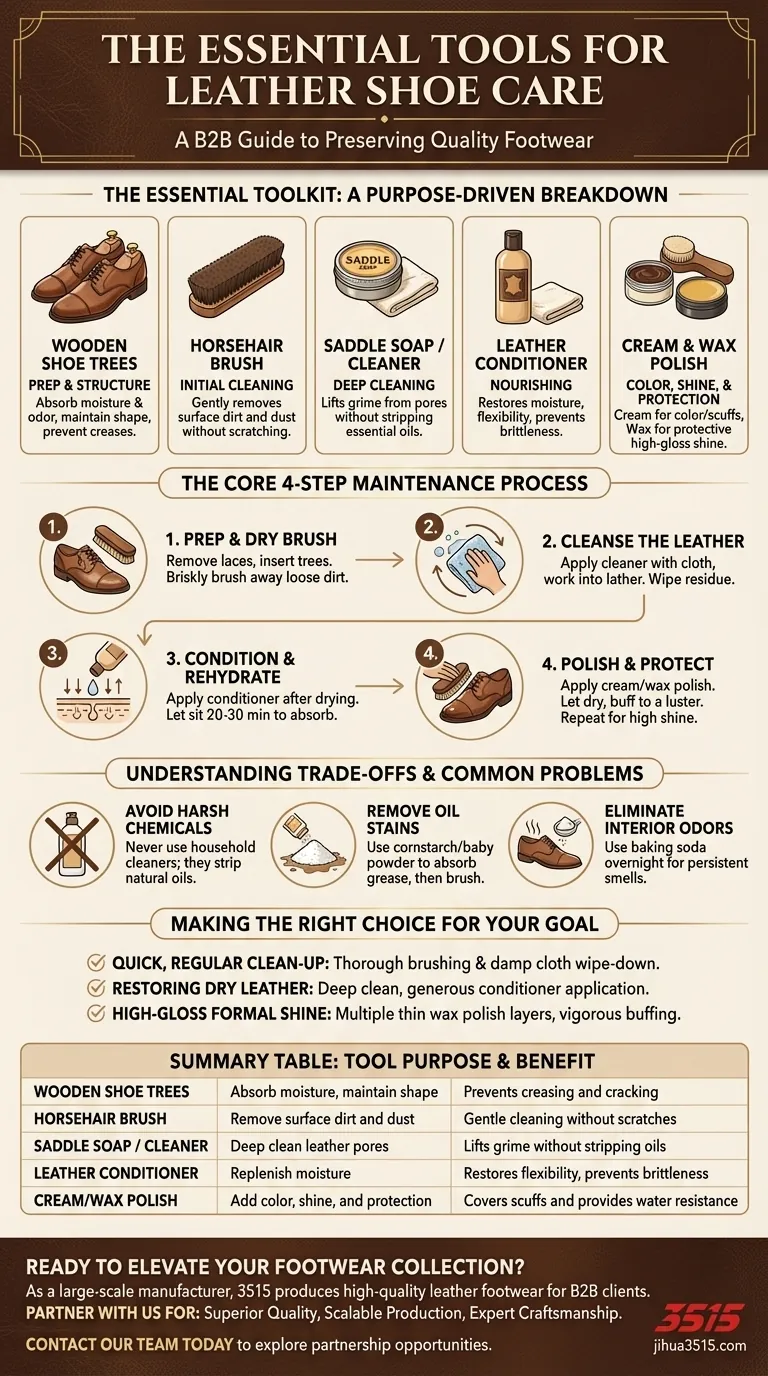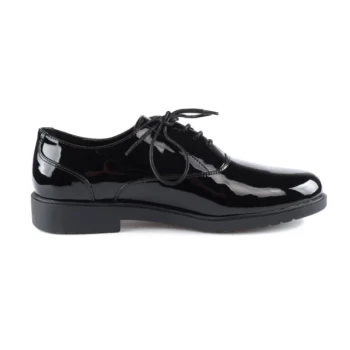To properly clean and maintain leather shoes, you need more than just a cloth and some polish. The essential toolkit includes wooden shoe trees, a horsehair brush for cleaning, a gentle cleanser like saddle soap, a quality leather conditioner, and the appropriate cream or wax polish. Each tool serves a specific purpose in a sequence designed to preserve the leather's health and appearance.
The right tools are only half the equation. A proper leather care routine involves a distinct sequence: removing surface dirt, deep cleaning the leather, conditioning to restore moisture, and finally, polishing to protect and add shine.

The Essential Toolkit: A Purpose-Driven Breakdown
Understanding what each tool does is the first step toward effective shoe care. Think of this not as a random collection of items, but as a system where each component prepares the shoe for the next step.
For Preparation & Structure
The process begins before you even start cleaning. Wooden shoe trees are non-negotiable for serious care. They absorb moisture and odor from the inside while maintaining the shoe's shape, preventing the leather from creasing and cracking as it dries. Laying down newspaper or a towel simply protects your work surface.
For Initial Cleaning
A horsehair brush is the first tool you will actively use. Its bristles are stiff enough to remove caked-on mud and surface dust but soft enough that they won't scratch the leather. This dry-brushing step is critical for preventing you from grinding dirt into the leather during wet cleaning.
For Deep Cleaning
Once surface debris is gone, you need a gentle cleanser. Saddle soap or a dedicated leather cleaner is ideal. These products are formulated to lift dirt and old polish from the leather's pores without stripping its essential oils. You will apply this with a soft cotton or microfiber cloth.
For Nourishing the Leather
After cleaning, the leather is stripped of some moisture and needs to be replenished. A high-quality leather conditioner is like moisturizer for the skin. It penetrates the leather to restore flexibility and prevent it from becoming dry and brittle over time.
For Color, Shine, & Protection
This final stage involves polishes. Cream polish contains pigments to restore color and cover scuffs, and it also offers some conditioning. Wax polish provides less color but creates a hard, protective barrier on the surface that delivers a high-gloss shine and a degree of water resistance.
The Core 4-Step Maintenance Process
With your tools assembled, the process itself is straightforward and methodical. Rushing any step will diminish the final result.
Step 1: Prep and Dry Brush
First, remove the laces to ensure you can access the entire shoe, especially the tongue. Insert your shoe trees. Then, use your horsehair brush to vigorously brush away all loose dirt and dust from the entire shoe, paying special attention to the welt where the upper meets the sole.
Step 2: Cleanse the Leather
Apply a small amount of saddle soap or leather cleaner to a damp cloth. Work the cleaner into the leather using small, circular motions, covering one panel of the shoe at a time. You will see a light lather form. Use a separate clean, damp cloth to wipe away all soap residue.
Step 3: Condition and Rehydrate
After the shoes are completely dry, apply a small amount of leather conditioner with a clean cloth. Use gentle, circular motions to work it into the entire shoe. Let the shoes sit for at least 20-30 minutes to allow the conditioner to fully absorb into the leather.
Step 4: Polish and Protect
If restoring color, apply a thin layer of cream polish. For a protective shine, follow with wax polish. Apply the polish in small, circular motions with a cloth or applicator brush. Let the polish dry, then use a clean horsehair brush to buff the entire shoe to a soft luster. For a higher shine, repeat with another layer of wax polish and buff with a soft cloth.
Understanding the Trade-offs & Common Problems
Avoiding common mistakes is as important as following the correct steps. Using the wrong products or techniques can cause irreversible damage.
The Mistake of Using Harsh Chemicals
Never use household cleaners, detergents, or vinegar on your leather shoes. These products are too alkaline or acidic and will strip the natural oils from the leather, causing it to dry out, discolor, and crack.
Removing Stubborn Oil Stains
For grease or oil stains, do not use water. Instead, cover the stain with a layer of cornstarch or baby powder. Let it sit for several hours to absorb the oil, then gently brush it off.
Eliminating Interior Odors
If the inside of your shoes has an odor, placing them on shoe trees in a well-ventilated area is often enough. For persistent smells, you can sprinkle baking soda inside and let it sit overnight before tipping it out.
Making the Right Choice for Your Goal
Your approach can be tailored to the specific outcome you need.
- If your primary focus is a quick, regular clean-up: A thorough brushing to remove dust followed by a wipe-down with a damp cloth is your go-to weekly maintenance.
- If your primary focus is restoring dry, tired leather: Prioritize a deep clean with saddle soap followed by a generous, patient application of leather conditioner, allowing it ample time to absorb.
- If your primary focus is achieving a high-gloss, formal shine: The key is using multiple, extremely thin layers of wax polish, with vigorous buffing and drying time between each layer.
By understanding the purpose of each tool, you can transform shoe care from a chore into a rewarding maintenance ritual.
Summary Table:
| Tool | Primary Purpose | Key Benefit |
|---|---|---|
| Wooden Shoe Trees | Absorb moisture, maintain shape | Prevents creasing and cracking |
| Horsehair Brush | Remove surface dirt and dust | Gentle cleaning without scratches |
| Saddle Soap / Cleaner | Deep clean leather pores | Lifts grime without stripping oils |
| Leather Conditioner | Replenish moisture | Restores flexibility, prevents brittleness |
| Cream/Wax Polish | Add color, shine, and protection | Covers scuffs and provides water resistance |
Ready to Elevate Your Footwear Collection?
As a large-scale manufacturer, 3515 produces a comprehensive range of high-quality leather footwear for distributors, brand owners, and bulk clients. Our production capabilities encompass all types of durable shoes and boots, built to last with proper care.
Partner with us to access:
- Superior Quality: Shoes crafted with premium materials, designed for longevity.
- Scalable Production: Reliable supply to meet the demands of your business.
- Expert Craftsmanship: Decades of experience in footwear manufacturing.
Let's discuss your needs. Contact our team today to explore partnership opportunities and elevate your product line.
Visual Guide

Related Products
- Wholesale Comfort Leather Business Shoes with Dial Lacing System
- Wholesale Comfortable Business Casual Shoes Custom Manufacturing
- Advanced KPU Athletic Safety Shoe with Steel Toe Cap Anti-Slip Rotary Lacing System
- Safety Footwear Wholesale Manufacturer for Custom OEM/ODM Production
- Wholesale Smart Casual Sneakers with Dial Closure | Factory Direct Manufacturing
People Also Ask
- How does top-grain leather differ from full-grain? Choose the Right Leather for Your Products
- Are sneakers acceptable in a business casual workplace? How to Choose the Right Style
- What are the benefits of seamless leather in office work shoes? Eliminate Friction for All-Day Comfort
- What are the environmental benefits of choosing real leather shoes? Durability and Waste Reduction
- What are the key features of high-quality leather in shoes? Invest in Durability and a Perfect Fit



















